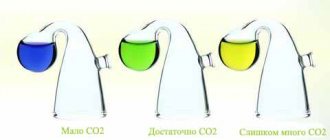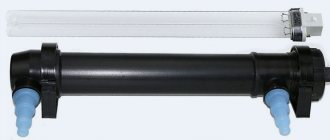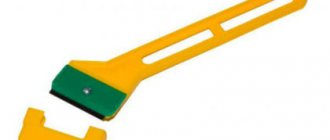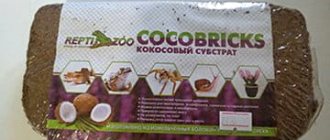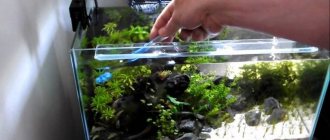Activated carbon has been familiar to every person since childhood, but few people know that this product is used not only in medicine, but also in aquarium farming. Aquarium carbon is produced by burning the starting material in an environment devoid of oxygen, due to which the substance has a porous structure and has adsorption properties. In other words, using activated carbon for an aquarium allows you to purify the water - this is the main reason why aquarists need carbon. However, the substance must be used correctly, otherwise it can seriously harm the small inhabitants of the reservoir.
What is activated carbon?
Activated carbon for aquariums is obtained from wood, fruit seeds, coconuts and other natural materials suitable for the preparation of the drug.
The manufacturing process is carried out thermally in a vacuum environment. The temperature for activation rises to 1000 degrees. During the heating process, coal acquires a porous structure and is endowed with special properties. The lighter the drug, the better the activation process. Parameters of such a substance: S_surface = 500-1000 m^2/g.
Important: aquarium charcoal is purchased only in specialized aquarium stores. Pharmacy or industrial ones are not suitable for these purposes. The fact is that these types have various additives in the form of acids, additives and other elements. The use of such a substance leads to the death of the home pond.
Nature and form
Activation occurs by burning primary solid material in an oxygen-free environment. After this procedure, wood and a small amount of ash remain. The finished product is completely natural in composition and has a porous structure. Due to its porous structure, aquarium carbon is widely used as a water filter because it easily removes unpleasant odors, drugs and various contaminants from water. That is why aquarists use it to purify water for their animals.
Manufacturers make it in a variety of forms. The most popular are granules and balls. In addition, it is found in powder form, but this variety cannot be used to clean aquariums. When choosing it for an aquarium, it is worth remembering that the higher the degree of porosity, the higher its filtration capacity.
Harm and benefit
Like any drug, coal has its own beneficial and harmful properties. The adsorbing properties of the drug leave no doubt. But in addition to harmful compounds, it also removes useful ones. In other words: it displays everything it can. He doesn't know good from bad. Under his “broom” are:
- Organic compounds,
- Medicines,
- Salts of heavy metals,
- Chemically active elements,
- Microelements beneficial for plants.
The principle of operation is this: absorption of substances from water occurs through pores. Accordingly, they become clogged. There comes a time when the adsorbent is simply overfilled and then the reverse process begins. It is impossible to catch this moment, so coal is used in an aquarium only in cases of extreme necessity and for a short time. As for use in filtration devices, carbon for the filter is installed only after it has been cleaned mechanically. This is done to prevent the pores from becoming clogged with large particles of debris. In addition, it is absolutely not suitable for biofilters. The fact is that the pores of carbon are instantly clogged with bacteria, which makes it unsuitable for further use.
Adding activated carbon to an aquarium that has plants is not a good solution. It will remove all the useful microelements necessary for the normal development of greenery.
Activated carbon should be used in an aquarium during treatment of fish only after the process is completed in order to remove any remaining medication. In such cases, immediately use a large portion of the drug for 7 days. It is not needed during the treatment period itself.
A lot of novice aquarists want to see the water in an artificial pond crystal clear. They especially do this when they are about to pour tap water into the spawning area. Yes, the substance will cope with the task with a bang. But the “chemistry” of the aquatic environment will suffer greatly due to the oversaturation of ammonia and nitrite compounds. To achieve perfectly clean water, use the following proportion: 50 g per 50 liters of water. Trusted companies indicate their proportions on the packaging. If such information is not available, then this drug cannot be used. Such things are a direct indication of a fake. Another point that you need to pay attention to is appearance. Glossy charcoal is not activated. It cannot be used. A high-quality product has a matte surface.
Benefits of charcoal for an aquarium
The main positive property, which is why the substance is considered necessary and useful in the world of aquarium keeping, is the ability of coals to adsorb various impurities and substances - for example, chlorine, chloramine, organic matter and medications. It should be immediately noted that coal is not able to affect the content of nitrites and ammonia in aquarium water. It is also important that when used, the product has an equal effect on both harmful and beneficial substances, filtering them all.
The miraculous cleaning property of activated carbon in an aquarium does not last forever, and over time the substance stops working as its pores become clogged with fine dirt and debris. The service life of the carbon substance is individual and depends on the degree of pollution, volume and number of inhabitants of the tank, however, experienced aquatic enthusiasts note that it is impossible to use carbon substances for more than one month - this will lead to negative consequences. For better and high-quality cleaning of aquarium liquid, it is recommended to first carry out mechanical filtration, and only then use carbon for the filter.
Efficiency
Quality and subsequent effectiveness can be determined by several points:
- The more pores, the better.
- Pore diameter directly affects the quality of adsorption.
- Time of use. The longer the adsorbent is in the aquarium, the worse its performance.
In order not to get into trouble, you need to use a specialized drug. Usually the manufacturer indicates the service life of coal, but in fact the time of use is much less than stated. For example, carbon filters need to be changed every month. Otherwise, the destroyed adsorbent will return the accumulations back and reduce attempts to restore cleanliness to zero.
An indicator for replacing coal is yellowing of the water.
What is it used for?
Activated carbon is intended for various purposes, including medical ones. In the aquarium hobby it is used for:
- eliminating unpleasant odors and clarifying water;
- giving it special transparency;
- removal of additives, drugs and fertilizers.
It was noticed that if a partial change of water in the container where the fish swim is not carried out for several weeks, an unpleasant odor appears in it. A carbon filter for an aquarium can eliminate such problems and does not require special installation conditions.
Gaze
The first thing you need to be quite picky about when purchasing activated carbon is information. It states:
- Porosity (porous surface area and pore size),
- Weight,
- Application dosage,
- The material from which coal is made.
When opening the package you need to evaluate:
- Color (matte or glossy),
- Weight (the lighter the coal, the more porous it is),
- The number of pores and their sizes (the more and the fewer, the better),
- Presence of dust (charcoal must be washed before use).
How to make the right choice of activated carbon
When choosing this product for your aquarium, you should first of all pay attention to the following points:
- The size of the parts of a substance. Used too finely crushed (less than 2 mm in diameter) should be placed in special bags, otherwise its particles will spread throughout the aquarium, and this can cause harm to its inhabitants.
- Method of receipt. Treated with hydrochloric acid contains less phosphates, which is why it has the least effect on the alkaline balance of the aquatic environment.
- The form of release also matters. Thus, the balls improve the flow of water in the reactor, and the granules have a large tangential surface, which extends their service life. The choice in this case is individual based on the preferences of the aquarium holder.
- It is worth paying attention to the proportions - the weight of the coal and its volume. The lighter it is, the more porosity it has, which means its contact area is larger and its filtration properties are much higher.
- Coal coloring. The matte color of coal indicates its natural composition, but a brighter, glossy color indicates the content of chemical additives.
Possibility of recovery
Sometimes information comes out that aquarium coal can be restored. Some “Kulibins” are trying to do this. But, before you start using chemicals, it’s worth remembering how coal is made. To restore it, you will need the same process as during manufacture: heating to 1000 degrees without air access. It’s unlikely that anyone will have the necessary equipment. But you can “revive” it a little. This procedure is possible provided that the adsorbent has been used little. In this case, it is washed in ordinary water and heated in an ordinary oven. In this case, the organic matter is partially removed, and not all of the pores are opened. In fact, the manipulation is useless and its benefits are questionable. It's easier to buy a new one. Whatever one may say, “the game is not worth the candle,” and it is better to find another, more useful use for finances.
Organic contaminants in a marine aquarium
Through a series of recycling systems, the world's reefs and oceans maintain a remarkably fine balance between metabolic pollutants and nutrients. However, living conditions in marine aquariums, based on artificial salts, lighting, frozen food and extremely high stocking densities, are completely different from living conditions in the natural environment. While inorganic ammonia and nutrients are easily controlled through biological filtration, many organic compounds accumulate and are resistant to microbial degradation. By and large, these natural metabolic substances remain undetectable but include organic acids, phenols, proteins, carbohydrates, hormones and antibiotics. Few of them have a direct toxic effect on marine animals, stimulate the development of heterotrophic bacteria, promote the formation of carbon dioxide, reduce pH and oxidation-reduction potential and, therefore, increase the aquarium's oxygen demand.
Certain organic compounds that color water yellow reduce the penetrating ability of light, especially actinic (420 nm) radiation. It is difficult to determine exactly what substances are present in an aquarium and what effects it has on different organisms. It is clear that systems with a high organic load have problems with infection, fish development rates are reduced, and invertebrates slow down or stop developing. Some researchers suggest a direct link between high levels of organic pollutants and disease incidence among aquatic organisms. Reducing the concentration of these substances certainly leads to improved water quality and healthier aquarium inhabitants. Activated carbon is one of the most effective and simplest methods for removing organic compounds.
How to use a carbon filter for an aquarium
Experienced aquarists, if necessary, use activated carbon to purify water, use a reactor. In addition to it, you need to purchase a falling water pump and a bag for the substance itself.
Next, the coal is placed in a purchased bag and washed under reverse osmosis water. This is necessary in order to remove all dust from it. It is then placed in a reactor and water is turned on at a flow rate of approximately 1,300 liters per hour. Do not create too much water pressure. Otherwise, the contact time of the liquid with the carbon is reduced, which makes the use of the filter less effective.
Is a filter needed?
Experienced aquarists know how to maintain water at optimal levels. If a person is just starting to breed fish and has decided to use a carbon filter for the first time, then it is worth carefully monitoring the condition of the water.
If it turns yellow and emits an unpleasant odor, then you can leave the device for two or three days and see how it works.
But if there are corals of different natures in the aquarium, then it is necessary to use only an acid-washed substance and carefully observe the results.
Disadvantages of a carbon filter
Whether a carbon filter is needed for an aquarium depends entirely on the operation being carried out. It is known that the substance is not able to distinguish which compounds need to be removed and which should be left behind. If the aquarist uses mineral fertilizer for plants, the filter will interfere with their absorption and the algae will not receive enough nutrition. The same applies to any other useful supplements. In addition, activated carbon creates dust, which sometimes causes erosion on the head and sides of fish. Of course, there is no scientific data on this topic yet, but it should be kept in mind.
Phosphates can also form from the black substance if coal that has not been acid washed is used. As a result, massive algae blooms are possible. To test coal for phosphates, there are special test kits that can be purchased at a pet store.
Filter maintenance
Maintenance of devices boils down to cleaning them as they become dirty. Used external filter canisters only need to be opened and washed every six months. However, only ceramic parts and foam rubber are subject to the caring process. In addition, you must use only aquarium water.
Homemade filters also have some nuances. After starting, for the first time they work like mechanical ones. The substrate used quickly fills with dirt, which leads to a decrease in productivity. Meanwhile, favorable soil is created for the proliferation of bacteria. They quickly accumulate and their secreted substances turn into nitrate. Thus, the filter self-cleanses biologically. To prevent harmful substances from entering the water, it is necessary to clean it after 2-4 weeks.
All about coal for an aquarium
Aquarium carbon
Aquarium carbon is used for physical adsorption of “contaminants” in the aquarium. It can be used in all types of aquariums: marine, freshwater, freshwater herbal.
Of course, in each such aquarium it is necessary to take into account the characteristics and properties of coal. Regarding aquariums with plants, there is a separate topic on our forum about the use of coal in a herbalist -. You can learn the remaining features and properties of coal for an aquarium from the passage quoted below from S. Spott’s book “Keeping Fish in Closed Systems.”
But before that, let us draw your attention to the main points:
1. Before use, aquarium carbon must be washed to get rid of suspended matter. Otherwise, all the “black dust” will end up in the aquarium.
2. Choose high-quality coal, coarse, not sandy fraction. For example, from Laguna or Tetra. In any case, we do not recommend using cheap coal. This is due to its properties. Cheap coal is less efficient and short-lived.
3. The service life of activated aquarium carbon cannot be determined. Since this value depends on many individual factors of the aquarium and the properties of a particular adsorbent. The average period of coal use ranges from 2 weeks to 1 month. If you use charcoal after treating fish to extract medications, it is recommended to remove it immediately after the medications have been completely removed, approximately 3-7 days.
Charcoal for aquarium Laguna
Water purification with active carbon
Some components of dissolved organic matter (POB) can be extracted from aquarium water by activated carbon. Activated carbon is prepared in two stages. The first stage is roasting, during which carbon-containing materials such as coal, animal bones, wood or nut shells are heated to red heat (about 600 C) to remove the hydrocarbons. To avoid complete combustion, firing is carried out virtually without air access. The next stage is activation. Firing is repeated this time at a temperature of 900 C in the presence of an oxidizing gas. This gas creates an internal porous surface of the coal, on which the DOM extracted from the water will subsequently settle (Fig. 3.2). When removing adsorbate from a liquid medium, pore size is usually not of great importance (Tchobanoglous, 1972).
Charcoal for Medos aquarium vladox
Granular or powdered active carbon is used. Although powdered carbon has a large binding surface, it is inconvenient to use and relatively expensive, so in the following we will mainly consider granular coal. Granular is called activated carbon (GAC) with particles larger than 0.1 mm (Tchobanoglous, 1972). Factors affecting adsorption efficiency. The efficiency of adsorption of dissolved organic matter on GAC depends on several factors, the most important of which are the mass transfer of the adsorbate into the coal granules, the duration of contact, the concentration and origin of the adsorbate, the size of the granules, the pore surface area and the uniformity of activated carbon fractions, and the presence of an organic film on the surface of the granules. Temperature and pH as factors influencing adsorption can be ignored, since in aquariums they must be maintained within a narrow range that ensures the normal functioning of animals and plants. Of the two, pH appears to be the more important. Morris and Weber (1964) noted that adsorption equilibrium is not affected by fluctuations in water temperature, especially in the range characteristic of natural waters. Tchobanoglous (1972) identified three independent stages in the adsorption process: transfer of the adsorbate to the water layer and the biological film surrounding the adsorbent, penetration into the pores of the GAC, and the formation of chemical bonds between the molecules of the adsorbate and activated carbon. The first two stages depend on the duration of contact, the third occurs instantly. Thus, molecular mass transfer is limited by the first two stages (Fig. 3.3).
The duration of contact between water containing DOM and activated carbon is of fundamental importance. If the duration of contact is very short, no mass transfer occurs. Increasing the duration of contact is achieved by lengthening the contact column or reducing the water flow through the contractor. The rate of adsorption varies in part as the square root of the adsorb concentration in solution (Morris and Weber, 1964).
Consequently, more adsorbate is extracted from a weakly saturated solution per unit time until traces of DOM are removed from the solution. However, the rate of adsorption increases with increasing concentration of the pollutant in the solution, but this relationship is nonlinear. Morris and Weber (1964) also found that large molecules (high molecular weight) settle more slowly than small ones. Moreover, the configuration of the molecules influenced the rate of their deposition: molecules with highly branched chains were adsorbed more slowly than molecules with a similar molecular weight, but more compact in structure. The rate of adsorption varies in part as the square of the diameter of the individual activated carbon granules (Morris and Weber, 1964). As already noted, the rate of diffusion of organic molecules at the interface of water and activated carbon is limited by mass transfer into the pores of the adsorbent. In turn, the size of active carbon granules affects the rate of mass transfer; With smaller particles, the extraction of DOM from water occurs faster. However, grinding large active carbon granules, although creating additional pores, does not lead to a noticeable increase in the adsorption rate (Morris and Weber, 1964).
The pore surface area of GAC can be expressed in general terms as molasses number, phenolic number, or iodine number. The molecules of each of these chemicals are of different sizes, and the extent to which it can be adsorbed depends on the number of pores of a certain size on the surface of the activated carbon granules. Iodine molecules, being the smallest ones, give an idea of the total surface area of the pores. The molasses number characterizes the number of large pores, and the phenolic number characterizes the number of pores of intermediate size. Iodine, molasses and phenolic numbers make it possible to approximately judge the potential adsorption capacity of activated carbon of a given type. However, Sontheimer (1974), testing three types of GAC in experiments to remove total organic carbon from waste water, did not find a definite dependence of the adsorption capacity of granules on either the phenolic number or the pore surface area. The last factor determining the rate of adsorption is the formation of an organic film. Granules placed in water are very quickly covered with a film of mucus produced by bacteria. On the one hand, it prevents the penetration of heavy DOM molecules into the GAC (NcCreary and Snceyink, 1977), on the other hand, it ensures the removal of DOM from the water after the physical adsorption capacity of the granular carbon column is exhausted (Maqsood and Benedek, 1977). The latter process is due to the duration of heterotrophic bacteria inhabiting the mucus. Design of GAU contactors. Activated carbon granules are usually placed in a separate container, called a contactor. Pouring granules directly onto the filter layer is inconvenient, since the spent granules must be periodically separated from the gravel and removed from the aquarium. In small aquariums, a standard corner airlift filter can be used as a contactor. To protect the active carbon granules from mucus, a dense layer of glass wool is placed on top of them. For large aquariums, the contactor can be made from a piece of polyvinyl chloride tube (Fig. 3.4). For convenience, threads are made at both ends of the contactor tube and removable adapter couplings are screwed on. At the outlet end of the tube, in order to prevent the removal of coal particles into the airlift, a porous plate, a piece of nylon sieve or a glass wool plug is installed. A flexible hose with a tip equipped with a tap is connected to the output end of the contactor tube. A bypass valve is included in the circuit (Figure 3.5) so that water can be passed through the biological filter when the contactor is disconnected for recharging. Ideally, the contactor should be installed immediately after the biological filter (Fig. 3.6). As a result of heterotrophic oxidative processes, many components of the DOM are mineralized, which reduces the load on activated carbon and extends its service life. The contactors shown in Fig. 3.4 and 3.6, are replaced after switching the water flow back to the aquarium, then the front and rear couplings are disconnected. This procedure is simplified if flexible connecting hoses are used instead of rigid PVC pipes. The used GAC is replaced with a new one, pre-washed in clean tap water to remove dust. To prevent water from seeping into the joints, the threaded ends are wrapped with Teflon tape.
GAC contactors for very large aquariums can be made from a 200-liter steel barrel with a removable lid (Fig. 3.7). To protect against corrosion, the internal surfaces of the tank and lid are coated with two layers of epoxy paint. Two holes (2.54 cm in diameter) are drilled in the wall of the barrel: one on top, the other on bottom. Threaded polyvinyl chloride flanges with a diameter of 2.54 cm are inserted into the holes and secured from the inside together with a sealing washer with stainless steel bolts; flexible polyvinyl chloride hoses are screwed onto the outer ends of the flanges. If you stretch a plastic mesh onto the inner end of the flange, there is no need to install a board, as is done in a gravel filter. The mesh prevents the airlift from sucking activated carbon particles into the aquarium. Water must be supplied to the circuit via a bypass route through a filter, as shown in Fig. 3.5. The barrel is filled 3/4 full with washed GAU. One refill is enough to clean 4000 liters. aquarium water.
Large aquarium systems require a contactor with mechanical pumps to clean. Most high-pressure sand filters are also suitable for these purposes. Instead of sand and gravel, these units are filled with active carbon. It is advisable to provide the filter with a removable lid, since active carbon must be changed periodically (Fig. 3.8).
Active carbon. The adsorption capacity of activated carbon gradually decreases as it is used, and eventually the material has to be replaced or restored. Otherwise, desorption occurs, and dissolved organic substances from the pores of the adsorbent again go into solution. Reactivation involves firing coal granules at high temperatures under pressure. However, even with this regime, only the largest pores open (Joyce and Sukenik, 1964), so with each reactivation the adsorption capacity of the granules decreases and, apparently, it never reaches its original value. It is recommended to take 1 g of granules per 1 liter of aquarium water and completely replace the adsorbent every 2 months. Mineralization of dissolved organic matter by heterotrophic bacteria settling on the surface of the granules gives the impression that the adsorbent is still working, although in fact its adsorption capacity has already been exhausted (Naqsood and Benedek, 1977). The only way to register the onset of desorption is to constantly monitor the total organic carbon content (oxidability) in the water leaving the adsorption column.
>How to purify water in an aquarium with activated carbon?
Benefits of external filters
An external device has many advantages. Among them, experienced aquarists identify the following:
- does not take up useful space inside the aquarium;
- makes the container more aesthetically pleasing;
- better purify water from contamination.
Of course, it is necessary to choose a purification system not only based on its capabilities, but also on price. But the cost is often too high, so you can use the above diagram and make the product yourself. Everything you need is sold in pet stores, and the assembly itself is quite simple.
Different types of filters
Carbon filters for an aquarium, photos of which are presented in this article, can be external or internal. Sometimes it is difficult to decide which one is suitable in each specific case.
Beginning aquarists are first advised to focus on the size of the fish tank. If the aquarium is large, then there is no fundamental difference. But often they install small or medium-sized fish houses. In this case, it is optimal to use an external filter. Unlike the internal one, it is installed outside the tank, which saves space for aquatic inhabitants.
The operating features of such a device are as follows:
- water enters the filter;
- cleared;
- returns back to the fish.
Features of use
Often corals and all kinds of plants are placed in the aquarium. However, for the full growth of its inhabitants, light is necessary. In order for the lamps used to achieve full efficiency, the water must be transparent. A carbon filter for aquariums is useful for this. As a result of its installation, all substances that interfere with the penetration of light disappear. But experienced aquarists warn that charcoal should be used carefully:
- if there are a lot of corals in a container with water, then a large amount of black substance can harm them;
- when the water was cloudy before, the corals experience a slight shock when it suddenly brightens.
To understand whether it is necessary to purify the water, it is worth looking at the container with fish from the side of one of its walls. If the opposite glass is not visible, then you will need a carbon filter for aquariums. It is able to clean the container from dissolved organic matter and make the water clear.
Manufacturing principle
It is quite possible to make a carbon filter for an aquarium with your own hands at home. It is known that a good device is not cheap. For those who want to save money, we suggest considering a simple model for water purification. To do this, you need to prepare a sponge, the size of which is selected depending on the volume of the aquarium, as well as:
- suction cup;
- spray;
- rubber tube;
- small compressor;
- two syringes (20 ml).
You need to take a syringe and make holes with a heated awl in the part where the medicine is taken. The first syringe should be connected by soldering to the second. To do this, you can hold the widest ends on a hot plate and quickly connect them, holding them tightly for 5 seconds. The part into which the needle is inserted must be cut off. The result will be a long tube.
You need to make a deep, but not wide, cut in the sponge, and insert part of the syringe into it. Next, a rubber tube is inserted into the pipe and connected to the selected compressor. A suction cup is attached to the other side to hold the structure on the wall of the aquarium.
